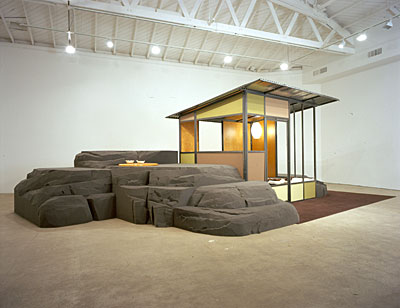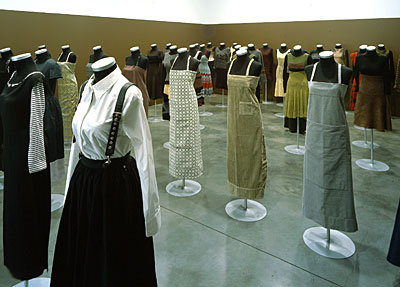It’s sometimes hard to know what to think when you’re looking at an exhibit. It’s harder when a museum’s entire arsenal of opinion shaping is being brought to bear on you. One can long for a dark quiet room to retreat and think. The Murakami exhibit at LAMoCA has a dark room, but it’s got movies playing inside. It will have to do.
Sitting in the dark watching Murakami’s forays into animation and live action film, trying to get my head around the sheer volume of things – paintings, sculpture, installations, products, etc. – in the main exhibit outside, I began to wonder, is it a good thing that we live in an age where artists have the means to make whatever comes to mind without concern for patronage?
It’s not the thirty-foot cast aluminum Buddha with a platinum patina. It’s not the startlingly similar paintings, or the acres of wallpaper. Not even the slightly sepulchral room in which Murakami’s ‘multiples’ (has that word ever been a thinner art-veil for the ordinary word ‘merchandise’?). It’s all of it taken together under the banner of one artist that makes me worried. The disappearance of dozens -- perhaps scores -- of people’s labor in the manufacturing of a brand of contemporary art seems suddenly disturbing.
Whoa there, don’t think I’m going to rant about the sell-out factor. I love sellouts. They give me something to buy. I’m not opposed to Murakami or anyone making work at a variety of prices for anyone – from sticker-struck kids to LV bag mules. What imparts a vaguely unpleasant, metallic taste to exhibit experience is the way all this is taken to be interesting when some of it is not. Which brings me to patronage.
Once upon a time, artists lavished materials and technique on objects made to realize a patron’s world-view. Religious or secular narratives of power were given splendid props by artists and artisans who learned to balance their own interpretations with the cultural frame in which they worked. Works became memorable for the extent to which they encompassed the complexities of their subjects – shared concerns of a whole society - and balanced them against the individual's vision.
Now, not so much. The watershed moment in art of the last 200 years has been the artist’s ability to determine his or her own ‘content’. Monet had his haystacks, Pollock had his drips, Warhol had his soup cans, Vito Acconci had his…well, Vito had a lot of things going on. But all of them were singular, individual, often idiosyncratic concerns that audiences took on faith were worth talking about. Murakami has singular, individual, and idiosyncratic down, but where preceding artists more or less made work in spite of mass-production, Murakami works on an industrial scale.
Not a public scale, an industrial one. The difference is important. In terms of glossiness of output, sheer size, degree of polish, Murakami is unbeatable. Everything seems ready to go into a store, ready to be consumed, as if it were already a souvenir of itself. (The show's biggest disappointment is that paintings wither in any room where sculpture is present, as if 2D work were just wrapping paper or stage dressing for the 3D objects.) There is little public memory in Murakami’s work (the oft-repeated mushroom clouds are an exception, but more on that in a minute). There is a fertile – almost fecund – play with images and characters, but they’re largely self-referential and seldom turn out to the world at large.
And, to what extent can Murakami really be seen as a Japanese artist? The question is a little goofy. Murakami is a global product-generating force. But the more I thought about it, the more I plowed through the exhibit’s luxurious, lavishly illustrated catalog and its accompanying essays, the more I realized I know nothing at all about Japan. And then I realized this wasn’t helping. Throughout the essays, the curators make strenuous efforts to connect Murakami to both American and Japanese contemporary art. I cannot say how successful they are on the Asian side, but some of the comparisons to American art are, well, reaching. This suggests that the connections to Japanese art and culture may be rather tenuous and perhaps should not be taken on faith. In my line of work, I read essays be people who want to convince me of things all the time. Often, I have no way of knowing if they’ve got their facts straight, let alone any real means of testing their interpretations of these facts. But when I come across a reference to something I know well, I can evaluate whether the writer is making sense on that point. If so, things should be okay throughout. If not… yipes.
Yipes.
So I hate this show, right? Wrong! I love it. But not for the reasons I felt the labels, curators, and institution want me to love it. First, Murakami may or may not be a genius, but what’s clear as glass from seeing this show is that he can marshal the skills and creativity of numerous invisible workers to make stunning installations and ensembles. Trying to cram him into the mould of the 20th century artist is too limiting for Murakami, who shines in his ability to collect and synthesize. Second, the show may not have much to say about Japan or America, but it has a lot to say about the emerging global interplay of images and ideas and, as such, it feels fresh and alive rather than clever but stale.


